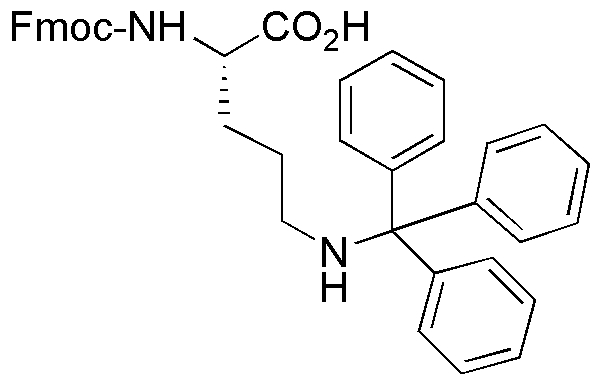Na-Fmoc-Nd-trityl-L-Ornithine is widely utilized in research focused on:
- Peptide Synthesis: This compound serves as a key building block in the synthesis of peptides, particularly in solid-phase peptide synthesis, allowing for the creation of complex and functional peptides.
- Drug Development: It plays a significant role in the development of peptide-based therapeutics, providing researchers with the ability to modify peptide structures for enhanced efficacy and stability.
- Bioconjugation: The chemical is used in bioconjugation processes, enabling the attachment of peptides to various biomolecules, which is essential in creating targeted drug delivery systems.
- Research in Neuroscience: It is utilized in studies related to neuropeptides, aiding in the exploration of their roles in neurological functions and potential treatments for neurological disorders.
- Custom Synthesis Services: Many laboratories offer custom synthesis services for this compound, catering to specific research needs and providing tailored solutions for scientists in academia and industry.
General Information
Properties
Safety and Regulations
Applications
Na-Fmoc-Nd-trityl-L-Ornithine is widely utilized in research focused on:
- Peptide Synthesis: This compound serves as a key building block in the synthesis of peptides, particularly in solid-phase peptide synthesis, allowing for the creation of complex and functional peptides.
- Drug Development: It plays a significant role in the development of peptide-based therapeutics, providing researchers with the ability to modify peptide structures for enhanced efficacy and stability.
- Bioconjugation: The chemical is used in bioconjugation processes, enabling the attachment of peptides to various biomolecules, which is essential in creating targeted drug delivery systems.
- Research in Neuroscience: It is utilized in studies related to neuropeptides, aiding in the exploration of their roles in neurological functions and potential treatments for neurological disorders.
- Custom Synthesis Services: Many laboratories offer custom synthesis services for this compound, catering to specific research needs and providing tailored solutions for scientists in academia and industry.
Documents
Safety Data Sheets (SDS)
The SDS provides comprehensive safety information on handling, storage, and disposal of the product.
Product Specification (PS)
The PS provides a comprehensive breakdown of the product’s properties, including chemical composition, physical state, purity, and storage requirements. It also details acceptable quality ranges and the product's intended applications.
Certificates of Analysis (COA)
Search for Certificates of Analysis (COA) by entering the products Lot Number. Lot and Batch Numbers can be found on a product’s label following the words ‘Lot’ or ‘Batch’.
Numéro de catalogue
Numéro de lot/série
Certificates Of Origin (COO)
This COO confirms the country where the product was manufactured, and also details the materials and components used in it and whether it is derived from natural, synthetic, or other specific sources. This certificate may be required for customs, trade, and regulatory compliance.
Numéro de catalogue
Numéro de lot/série
Safety Data Sheets (SDS)
The SDS provides comprehensive safety information on handling, storage, and disposal of the product.
DownloadProduct Specification (PS)
The PS provides a comprehensive breakdown of the product’s properties, including chemical composition, physical state, purity, and storage requirements. It also details acceptable quality ranges and the product's intended applications.
DownloadCertificates of Analysis (COA)
Search for Certificates of Analysis (COA) by entering the products Lot Number. Lot and Batch Numbers can be found on a product’s label following the words ‘Lot’ or ‘Batch’.
Numéro de catalogue
Numéro de lot/série
Certificates Of Origin (COO)
This COO confirms the country where the product was manufactured, and also details the materials and components used in it and whether it is derived from natural, synthetic, or other specific sources. This certificate may be required for customs, trade, and regulatory compliance.


